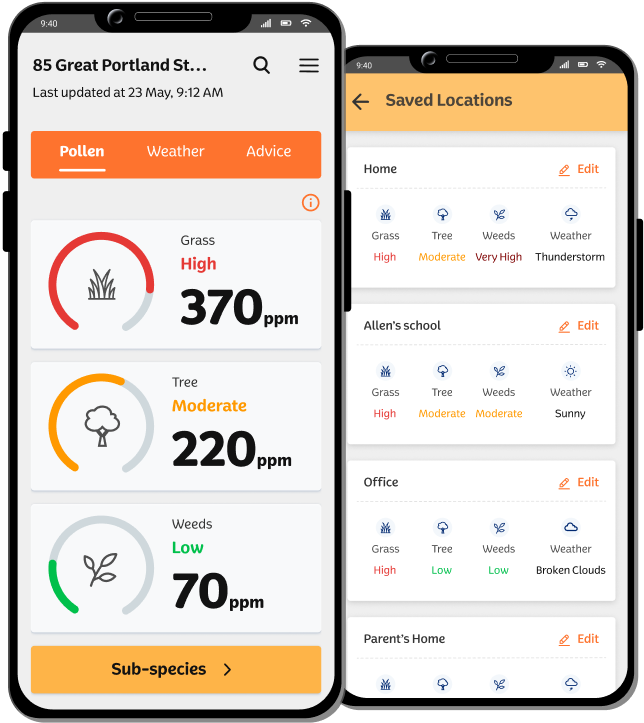Pollen Types and Their Impact on Hay Fever
With over 10 million people suffer from hay fever in England, it pays to know your pollen. From grass rash to ragweed allergies, you may not know what type of pollen you’re allergic to, but you will know the symptoms. Itchy eyes? Ugh. Irritated nose? Yuk. Rashes from pollen? Ouch.
To help you work out which type of pollen in the UK you’re allergic to, we’ve taken a closer look at the types of pollen out there.
List of Pollen Types
Know your enemy. For hay fever suffers, the foe is pollen – the fine, natural powder that helps plants reproduce. While lots of pollen is harmless, there are three types that can really get up your nose:
- Tree pollen
- Grass pollen
- Weed pollen
These pollen types can be carried by wind and don’t care who gets in the way. For the millions of us in the UK who have hay fever, our bodies see these pollen particles as an intruder and go into full-on fight mode.
You’ll sneeze to force the pollen out. Your eyes will water to wash the particles away. You’ll get a snotty nose to clear out your nostrils. But symptoms vary depending on the pollen type you’re allergic to. You may suffer from a grass rash, although there are other grass, ragweed and tree allergy symptoms.
If you have a serious pollen allergy or severe hay fever symptoms, it’s best to chat to your doctor or a specialist to help identify your allergens.
Types of tree pollen
You guessed it, this is pollen from the flowers of a tree. But there are different types of tree pollen.
- Birch Pollen. Silver birch pollen allergy is one of the most common and occurs from March to June, peaking between April and May. It can cause asthma and rhinoconjunctivitis (basically irritated eyes, nose and sinuses). Found in lightly wooded areas, look out for the birch tree’s recognisable white bark.
- Oak pollen. Like birch, it’s around March to June but is particularly bad in May. Oak pollen is the next most common hay fever allergen with symptoms including a cough, watery and itchy eyes, and an irritated throat.
- Pine pollen. Pine trees are easily recognisable by their needles. Its pollen is considered a health food, but we’re betting you don’t care about that when you’re feeling rough. It’s in the air from April to July, peaking in May.
- Alder pollen. Yellow-red alder trees like damp areas and watch out January to April – the pollen peaks in March. It’s like that produced by birch, so if you notice a reaction to birch pollen steer clear of alders too.
- Hazel pollen. You can spot a hazel tree by its smooth, grey-brown bark (which peels as it ages). It likes the edges of wooded areas, and releases its pollen January to April, with a peak in February and March.
- Yew pollen. This tree is found mostly in southern England. It has small needles, red berries and is poisonous to us humans. Its pollen won’t kill you, but it could make you miserable from January to April, especially in March.
- Elm pollen. English elms have rough, grey-brown bark and often have suckers growing at the base of the trunk. They send out their pollen beween February and April.
- Willow pollen. Commonly found by rivers, willows have sweeping branches and slender leaves. Not many people are allergic but, for those unlucky few, pollen is around between February and April.
- Poplar pollen. Poplars like moist conditions, so you’re find them by water. Their bark is pale grey and has black diamond-shaped lines. Hay fever sufferers watch out between March and May.
- Ash pollen. Ash trees like a good water supply, so you’ll find them near water – and they can be recognised by their smooth, greyish-brown bark. Ash releases its pollen March to May.
- Plane pollen. These trees have multi-coloured bark and are mostly found in cities across the UK (you’ll see loads in London). Watch out for its pollen March through to May.
- Lime pollen. Found in parks and urban areas, lime trees send out their pollen in summer, typically June to July. Its leaves are dark green and heart-shaped.
Tree pollen season
In the UK, tree pollen season generally kicks off from late March to mid-May, causing tree allergy symptoms to flare up.. Peaks vary based on the weather, with dryer seasons being more bearable. The peak of the season can last from mid-May til June. That means snot, rashes from pollen and a constant hunt for tissues and tree pollen allergy treatments.
Don’t let it beat you. If you think you’re suffering due to tree pollen, use Your Pollen Pal to check if pollen levels in your area are high or low, and plan your days out that way.
Types of weed pollen
Weed pollen is harder to deal with than tree or grass pollen. Weeds grow everywhere and they keep coming back, and weed pollen is just as irritating. It’s released any time throughout the year, although weed pollen season generally covers late April to September.
- Ragweed pollen. Ragweed is an upright plant with fern-like leaves.
- Nettle pollen. A common weed found across the UK, nettles cause few allergies but plenty of stings…
- Dock pollen. Found in meadows and some coastal areas, the pollen from this weed can cause common hay fever symptoms. But they do help soothe a nettle sting, so swings and roundabouts.
- Mugwort pollen. Growing over two metres, you’ll spot mugwort by its red/brown colour and small flowers.
- Plantain pollen. Not the tasty banana-like fruit, this short plant has leaves growing directly from the soil.
Weed pollen season
Weed pollen season kicks off in the UK when the sun comes out – starting in late April and lasting through to the end of September, peaking in June through to September. Symptoms can include rashes from pollen, a stuffy nose and itchy eyes. Wet days can help, as rain washes pollen out of the air. But if it’s humid, such as during a thunderstorm, the pollen count can rapidly rise. Generally, following a hot day, your pollen allergies may be worse - even at night. If you’re desperate for a day out, then you could use a pollen forecast to choose the best time for you to leave the house.
Grass pollen types
While your grass allergy may present differently to the next person’s grass allergy, it seems there’s only one type of grass pollen. Despite the different types of grass that exist, they all look highly similar when put beneath a microscope, and just to confuse you even more, grass pollen allergies can affect people at different times of the year.
Grass pollen season
Grass pollen is thought to be one of the worst offenders when it comes to hay fever. Its allergy season begins towards the end of spring (around May). It peaks the beginning of summer (June to July) – just as tree pollen eases – and ends when autumn begins in September.
Common grass pollen allergy symptoms include irritated eyes, throat and nose, and grass rash. However, some other symptoms such as contact dermatitis (a form of eczema) and headaches can occur if you have severe allergies.
Here are some tips to manage grass allergy. For grass rash, you could wash the affected area, apply a cold compress, use antihistamines or specialised ointments. Antihistamines and washing could work for most of your symptoms, but preventative measures are your best defence.
You may notice an increase in your symptoms if you’re around grass for long periods of time, or when you cut the grass.
Check out our pollen calendar to see which pollen appears when, or just tap on Your Pollen Pal for your local pollen forecast.
Managing pollen allergy symptoms
Being allergic to one type of pollen doesn’t mean the others won’t affect you. A grass allergy could still affect someone with an oak pollen allergy, just as someone with an oak pollen allergy could still have a silver birch pollen allergy or a weed pollen allergy.
First up, work out exactly which pollens tickle your throat, irritate your eyes or make your skin flare up. We’re not asking you to cut the grass to find out. Visit Your Pollen Pal, take the quiz, and identify what allergies you could have. Then, you can prepare from there, so next time the pollen count spikes, you can show it who’s boss.
The content should not substitute medical advice from your personal healthcare provider. Please consult your healthcare provider for recommendations/diagnosis or treatment












